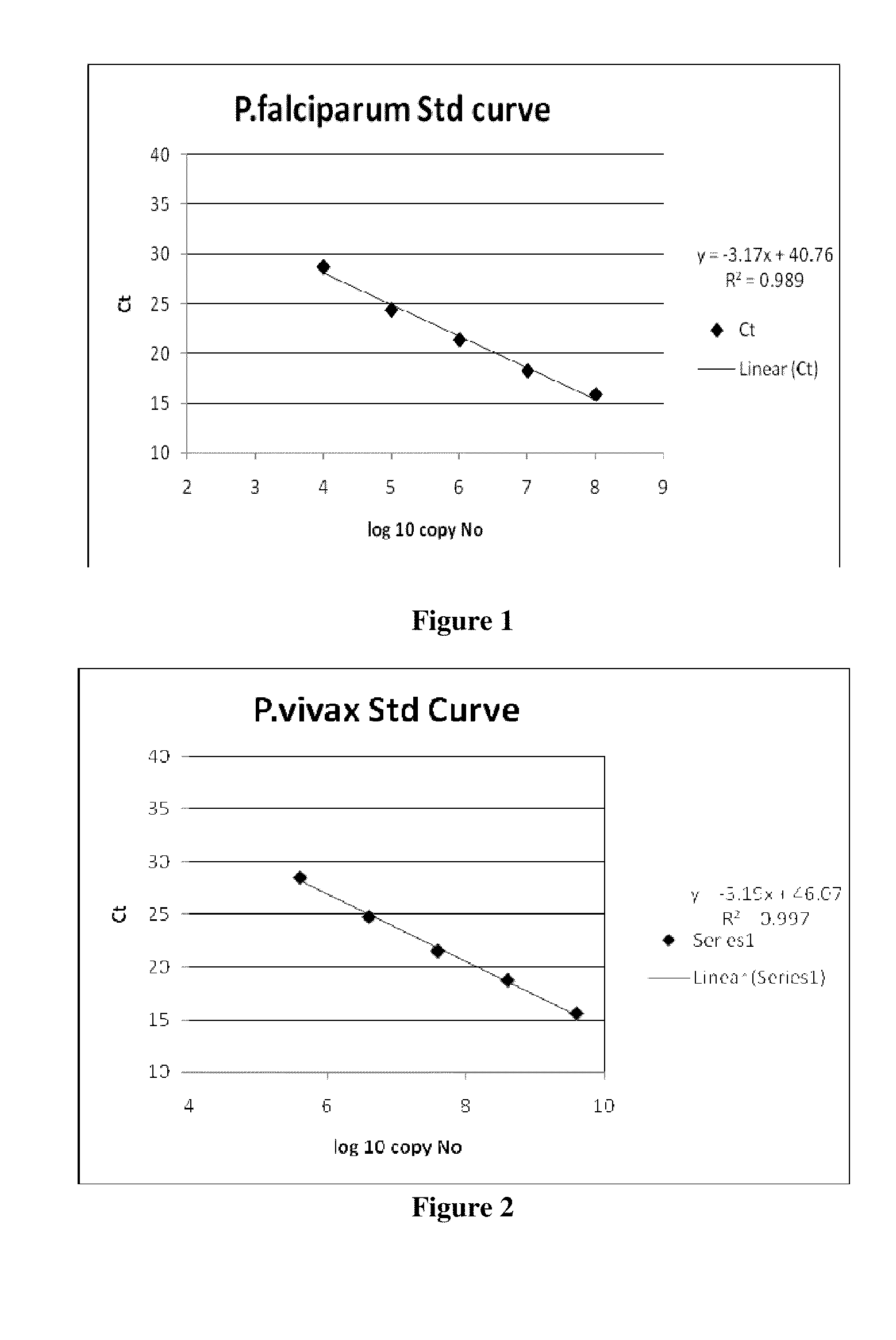Probes and Primers for Detection of Malaria
a technology of malarial infection and probes, applied in the field of malarial detection and quantification, can solve the problems of malarial resurgence, loss of productivity, and undermine the maintenance of a stable public-health infrastructur
- Summary
- Abstract
- Description
- Claims
- Application Information
AI Technical Summary
Benefits of technology
Problems solved by technology
Method used
Image
Examples
example 1
[0056]DNA was isolated from a sample panel consisting of 10 blood samples positive for Plasmodium falciparum and 10 uninfected blood samples. Similarly DNA was isolated from 10 blood samples positive for Plasmodium vivax and 10 uninfected blood samples using a commercial DNA isolation kit. The purified DNA was subjected to Real time PCR using SEQ ID No. 1 Probe along with SEQ ID No. 4 or 10 and 7 or SEQ ID No. 2 Probe along with SEQ ID Nos. 5 and 8 for the detection of Plasmodium Falciparum. Similarly SEQ ID No. 3 along with SEQ ID Nos. 6 and 9 was used for the detection of Plasmodium Vivax. Same concentrations of Real time-PCR reagents, template and primers were used in each case and also cycling conditions were kept constant for all the reactions. The composition of PCR mix and PCR conditions are as given in Table 4 & 5.
TABLE 4Real time-PCR with Takara PremixReal time PCR Master Mix CompositionPremix5.0 μlForward Primer0.2 μl(2picomoles)Reverse Primer0.2 μl(2picomoles)Probe0.2 μl(...
example 2
[0059]In another study DNA was isolated from a double blind sample panel consisting of 25 infected blood samples. The efficiency of SEQ ID Nos. 1, 2, & 3 in detecting malaria from infected blood samples were then tested by real time PCR. The results obtained were then compared with the other commercial techniques for malaria detection viz, microscopy and rapid diagnostic tests (RDT).
[0060]The results obtained showed that SEQ ID Nos. 1, 2 and 3 picked up even the cases of mixed infections which were shown as single infections by the other two techniques. If we look into the Ct values in case of mixed infections the Ct obtained for vivax infections were late and the parasite load at that Ct would be around 3-5 parasites / μl, which will be a very low count. The microscopy and RDT tests cannot detect such a low level of parasitemia and thus the infections reported by these two tests are as single infections. There were few samples which were not detected by the other two tests and the re...
example 3
[0061]One can also quantify the parasite load from an infected sample by comparing the Ct values obtained from a standard curve (FIGS. 1, 2) & (Tables 9, 10).
Protocol for Calculation of Copy Number
[0062]Around 25 microlitre of malarial DNA (P. Falciparum or P. Vivax) was subjected to PCR along with SEQ ID Nos. 4 or 10 and SEQ ID No.7 primers for P. Falciparum and SEQ ID No.6 and SEQ ID No.9 primers for P. Vivax using a conventional PCR machine. After PCR the amplified samples were run on a agarose gel and stained with ethidium bromide. The amplicon band was then excised from the gel and purified using a Qiaquick gel extraction kit. The absorbance (20 of DNA) was estimated at 260 nm using a nanodrop. Extinction coefficient of the DNA was calculated from individual base coefficient by summing up.
[0063]Nanomoles of amplicon was calculated using the following equation:
nmoles / ml=100×OD260(1cm)×1ml(vol)Extinctioncoefficientofamplicon
Copy number was calculated using the formula:
Copy number...
PUM
| Property | Measurement | Unit |
|---|---|---|
| acid | aaaaa | aaaaa |
| fluorescence | aaaaa | aaaaa |
| population density | aaaaa | aaaaa |
Abstract
Description
Claims
Application Information
 Login to View More
Login to View More - R&D
- Intellectual Property
- Life Sciences
- Materials
- Tech Scout
- Unparalleled Data Quality
- Higher Quality Content
- 60% Fewer Hallucinations
Browse by: Latest US Patents, China's latest patents, Technical Efficacy Thesaurus, Application Domain, Technology Topic, Popular Technical Reports.
© 2025 PatSnap. All rights reserved.Legal|Privacy policy|Modern Slavery Act Transparency Statement|Sitemap|About US| Contact US: help@patsnap.com


